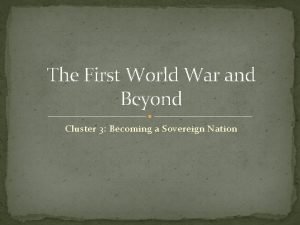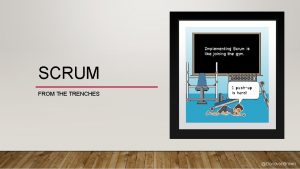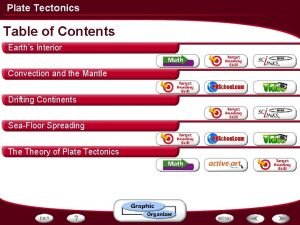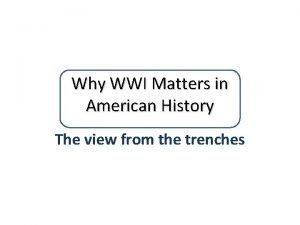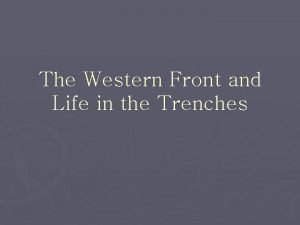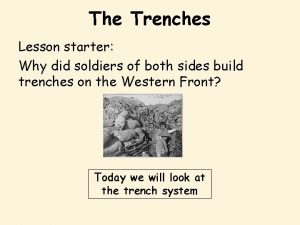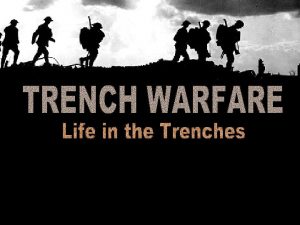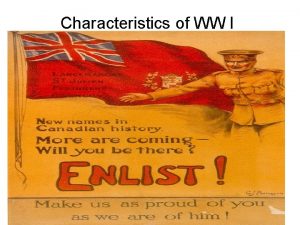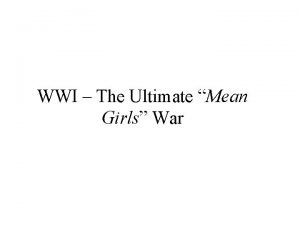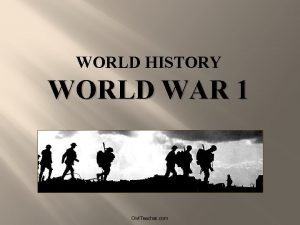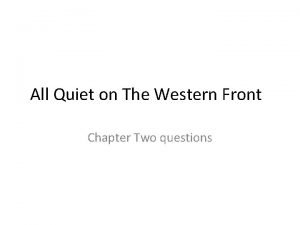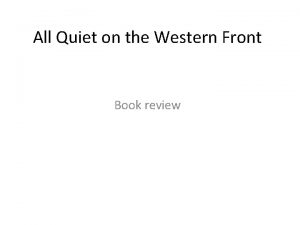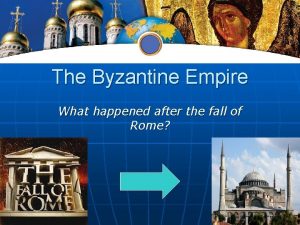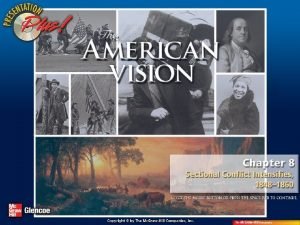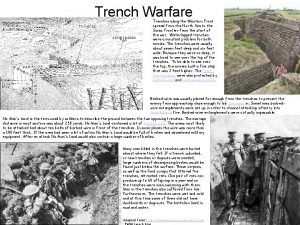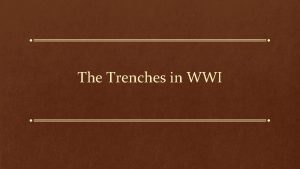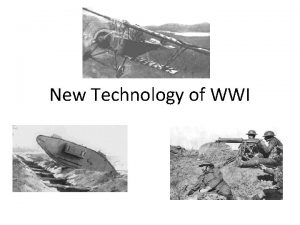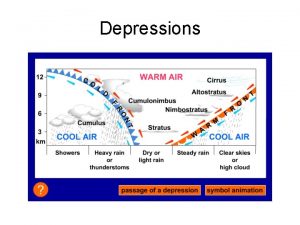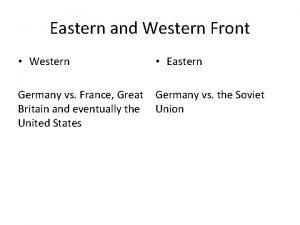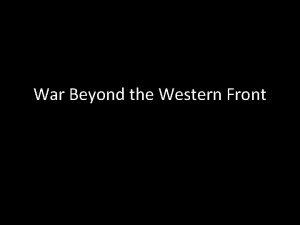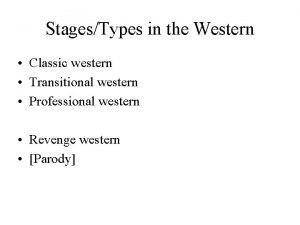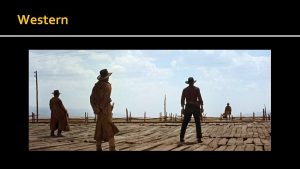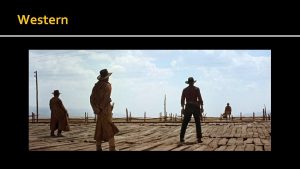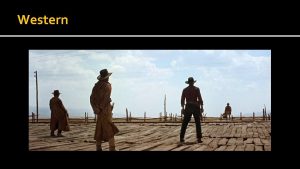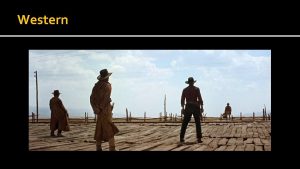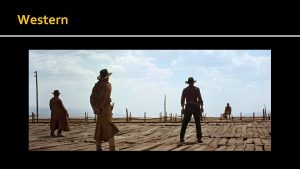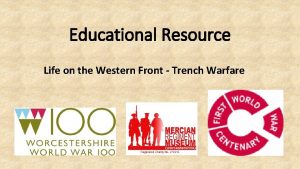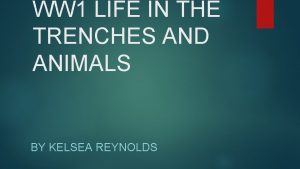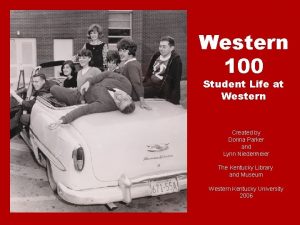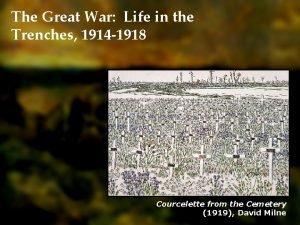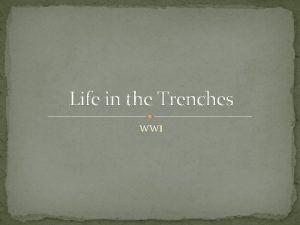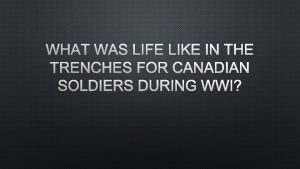The Western Front and Life in the Trenches

































![Chemical Warfare, Quote ► "[The] vapour settled to the ground like a swamp mist Chemical Warfare, Quote ► "[The] vapour settled to the ground like a swamp mist](https://slidetodoc.com/presentation_image/1ca377a0d8bde775eabdaa10b32bb053/image-34.jpg)






































- Slides: 72

The Western Front and Life in the Trenches

What was the Western Front?

The Western Front

The two main fronts: ► On your coloured and labeled map of the alliances in your workbook, mark the Western front and the Eastern front.

Schlieffen Plan ► 3 rd of Aug, 1914: ► The aim of the Von Schlieffen plan was to knock France out of the war quickly so that Germany did not have to fight the French and the Russians (=Eastern front) at the same time. ► The plan failed…

Why did the plan fail? ► See page 35. ► Write down: The Schlieffen plan failed because: ► (use short dot points)

The result of the failed plan: ► After the first Battle of the Marne (= one month later, 5 – 19 sept, 1914), both sides dug trenches; the war of attrition had begun. ► The western front became a deadlocked region of battlefields in Northern France where war turned into a long and bloody stalemate.

Why use trenches and how do they work?

What is in a Trench? ► Barbed wire: to make running at the trench difficult. ► Sandbagged parapet: to stop the trench collapsing. ► Parados: to stop ‘shrapnel’ getting into the trench. ► Fire step: to shoot from. ► Duck Boards: stopped the bottom of the trench getting very muddy and slippery.

Trench System http: //www. spartacus. schoolnet. co. uk/FWWtrenchsystem. htm

Tunneling

Trench Warfare: ► Trench Warfare: Armies fought each other in dugouts but it often led to long periods of stagnation and a high death toll.

The theory and the reality…

Fighting in Europe: ► By 1915, opposing armies on the Western Front had dug miles of parallel trenches to protect themselves from enemy fire. ► This type of warfare led to huge losses of human life for very small land gains.

Trench Warfare ► Attacks and Offensives - An attack usually involves a division (16, 000) and an offensive was larger (at least one corps). http: //www. spartacus. schoolnet. co. uk/FWWoffensive. htm


Weapons and trench war fare

Weapons in WW 1 1. Tanks 2. Gas 3. Machine guns 4. Airplanes 5. Artillery (shells, mortars, bombs)

Weapons in WW 1 You tube video of different weapons: http: //www. youtube. com/watch? v=3 IVyj. Zk 2 a 0&feature=Play. List&p=42281192 E 0 B 31876&playnext=1&index=4

Weapons in WW 1 ► Rapid technological innovation ► Technology changed, but mindset of commanders did not…. ► Soldiers trained in old fashioned techniques (charging at enemy)

Tanks ► Tanks: introduced by British in 1916 at the Battle of the Somme.

Tanks

Tanks ► ► ► Winston Churchill (lord of the admiralty and home secretary in WW 1) saw importance of tanks Germans were surprised by tanks but because of their initial failure, did not take them seriously. Germans did not devote large amounts of money, research or time to tank-development. But British and French continue to improve on initial flawed design. By end of war, tanks were used strategically to force break throughs.

Tanks ► See page 52 ► Tanks not used effectively by commanders until 1918 ► Germans did not see importance of tanks

Early tanks ► Very slow ► Chains ran off tracks ► Got stuck in mud ► Engines overheated ► Strategically misused and underused until 1918

Tanks ► You tube video showing tanks in use: ► http: //www. youtube. com/watch? v=i. HIp- hy. XKWc

Chemical warfare ► See page 49

Chemical Warfare ► French started with tear gas grenades. ► Germany used chemicals in artillery shells, bombs, and grenades. ► Gas masks developed quickly, became more sophisticated by end of war. ► (Another idea from British: Set up 100, 000 fans. ) ► Many types of gases were used, i. e: tear gas, mustard gas, chlorine gas

Chlorine Gas ► ► ► ► Used by both allies and central powers. Lung irritant. First developed by IG Farben, a German chemical company. Replaced by mustard gas and phosgene. Used in the Second Battle of Ypres. Distinctive smell – mixture of pineapple and pepper. Distinctive taste – metallic taste.

Phosgene ► U. S. developed chemical. ► Used by both Allies and Central powers. ► Irritates mucous and skin. ► Corrosive and toxic. ► Successor to Chlorine Gas.

Xylyl bromide (tear gas) ► Tear gas impeded ability to fight; incapacitated soldiers. ► Irritates eyes and lungs. ► Used by French in the form of grenades. ► Used by both sides ► Put into T-Shells, a shell with an explosive tip that was filled with tear gas. ► Easy to manufacture; was popular because of that.

Mustard Gas Causes blistering Incapacitates soldiers. Hard to counter, burns exposed skin. ► Put into a variety of artillery, bombs, and other munitions. ► Used by both sides. ► Was persistent. It would remain for days, clothing and equipment that had been contaminated would spread the gas. ► ► ►

Chemical warfare ► Soldiers wore gas masks. ► Photo of an early gas mask.
![Chemical Warfare Quote The vapour settled to the ground like a swamp mist Chemical Warfare, Quote ► "[The] vapour settled to the ground like a swamp mist](https://slidetodoc.com/presentation_image/1ca377a0d8bde775eabdaa10b32bb053/image-34.jpg)
Chemical Warfare, Quote ► "[The] vapour settled to the ground like a swamp mist and drifted toward the French trenches on a brisk wind. Its effect on the French was a violent nausea and faintness, followed by an utter collapse. It is believed that the Germans, who charged in behind the vapour, met no resistance at all, the French at their front being virtually paralyzed. " The use of gas at Langemarck ø as reported in the New York Tribune, April 27, 1915

Poison Gas: effects ► The gas eventually wore away. ► Most dead men were left ► Some died from the after-effects ► Explosions left environment poisoned and destroyed

Machine Guns

Machine Gun ► Fired ammunition automatically and could wipe out waves of attackers. ► The machine gun made it very difficult forces to advance across No Mans Land.

Bombs were very small in the beginning of the war. ► Small arrows called Flechettes were also dropped on the enemy. ► They were very inaccurate. ► Bombing did not become effective until later in the war. ► A bomber plane could carry one 1, 650 lb (=750 kg) bomb. ► Only Zeppelins could carry big bombs. ►

Mortars ► ► ► lobbed a shell in a high arc over a relatively short distance Widely used in trench fighting for harassing the forward trenches, for cutting wire in preparation for a raid or attack, and for destroying trenches. In 1914, the British fired a total of 545 mortar shells; in 1916, they fired over 6, 500, 000.

Airplanes

The Planes… Low speed / low altitude ► Most planes had low horse power. ► They were very flimsy and unstable. ► Hard to fly. ► Many WW 1 pilots died from accidents. ►

The Aces ► Manfred von Richthofen. (Germany) ► Edward "Eddie" Rickenbacker. (US) ► Von Richthofen had highest kill rate of any pilot. ► He was shot down by ground fire. ► Eddie had 27 kills. ► Richthofen had 80.

Zeppelins Went on recon missions. (reconnaissance = exploration) ► Used as high flying bomb throwers ► Heavily guarded by machine guns and anti aircraft guns. ► Very dangerous to pilots. ► Were as fast as airplanes ► Sometimes tethered to ground. ►

Submarines Germans introduced the submarine (U-boats) in 1914 as an effective warship ► its primary weapon was the torpedo = underwater missile. ► German unrestricted submarine warfare would be a major factor in bringing the U. S. into war. ►

Flame throwers ▪ ▪ ▪ http: //www. spartacus. schoolnet. co. uk/FWWflame. htm Flame throwers- First used on the Western Front in 1914 to clear enemy soldiers on front-line. Germans used it more often than allied powers. Dangerous to operator and depending on wind.

Infiltration tactics ► Both sides used small groups of experienced soldiers to sneak up on enemy and cut barbed wire. ► Then sent infantry across No Man’s Land. http: //www. spartacus. schoolnet. co. uk/FWWinfantry. htm


Casualties World War I took the lives of about 8. 5 million soldiers… Statistics at a glance: Germany= 1. 8 million Britain= 908, 000 Russia= 1. 7 million France= 1. 3 million Austria-Hungary= 1. 2 million

But why so many casualties? ► The new tools of war – machine guns, poison gas, armoured tanks, larger artillery - did not deliver the fast-moving war strategists had expected. ► The new technology just killed greater numbers of people more effectively.

Questions ► What prolonged effect would this type of warfare have on soldiers? ► How would trench warfare affect how countries felt at the end of the war? ► Would trench warfare be a good tactic to use today? Why and why not? ► How do you think you would feel as a WW 1 trench soldier? Write down 10 adjectives.

Daily life in the trenches

This is an entry in the diary of Harold Saunders, a soldier during World War One. He describes trench life as he knows it. When I made my debut in the line I had a cheerful conviction that nothing would hit me. And I remember standing on the fire-step for the first time and saying to myself exultantly: "You're in it at last! You're in it! The greatest thing that's ever happened!" Lice and wind-up came into my life about the same time. At stand-to one morning a flight of whizz-bangs skimmed the top of the trench. The man next to me went down with a scream and half his face gone. The sand-bag in front of me was ripped open and I was blinded and half-choked with its contents.

Days in the trenches ► Soldiers spent 8 days in trenches ► Trenches were about 3 metres deep ► Patrols were sent into No Man’s Land ► Fallen soldiers were often not buried. ► Trenches were called dug outs

The Trench Cycle Typically, a battalion would be expected to serve some time at the front line. ► This would be followed by a stint spent in support, and then in reserve lines. ► A period of rest would follow - generally short in duration - before the whole cycle of trench duty would start anew. ►

Inspection and Chores After breakfast, men would be inspected by either the company or platoon commander (This was called “Stand-to”). After that the soldiers were assigned daily chores. ► Daily chores included refilling of sandbags, repair of the duckboards and the draining of trenches. ► Particularly following heavy rainfall, trenches fill up with muddy water, making life more miserable for its occupants as the walls of the trench rapidly became misshapen and were prone to collapse. ►

Duckboards in no man’s land

Daily Boredom The front lines were constantly under watch by snipers and look-outs during daylight so movement was restricted until night fell. ► Thus, once men had concluded their chores, they were free to attend to more personal matters, such as the reading and writing of letters home. ► Meals were also prepared. Sleep was snatched wherever possible - although it was seldom that men were allowed sufficient time to grab more than a few minutes rest before they were assigned another task. ►

Dusk ► ► ► At nightfall, the morning ritual of stand-to was repeated, to guard against a surprise attack as light fell. After this, the trenches became a hive of activity. Supply and maintenance activities could be undertaken. Men would be sent to the rear lines to fetch rations and water. Other men would be assigned sentry duty (lookout, guarding) on the fire step. Generally men would be expected to provide sentry duty for up to two hours. Any longer and there was a real risk of men falling asleep on duty - for which the penalty was death by firing squad.


Patrolling No Man’s Land ► ► ► Patrols would often be sent out into No Mans Land. Some men were sent to add barbed wire to the front line. Others however would go out to assigned listening posts, hoping to pick up valuable information from the enemy lines. Sometimes enemy patrols would meet in No Man's Land. They were then faced with the option of hurrying on their separate ways or else engaging in hand to hand fighting. They could not afford to use their handguns while patrolling in No Man's Land, for fear of the machine gun fire it would inevitably attract, deadly to all members of the patrol.

Rat Infestation ► Millions of rats infested trenches. ► Two main types: the brown and the black rat. ► The brown rat was especially feared, they ate human remains (grotesquely disfiguring them by eating their eyes and liver). ► Could grow to the size of a cat. ► One male + female rat can produce up to 900 offspring in a year, spreading infection and contaminating food.



Frogs, lice and worse Lice were also never-ending problem causing men to itch unceasingly. ► Even when clothing was periodically washed and deloused, lice eggs invariably remained hidden in the seams. ► Lice caused Trench Fever, a particularly painful disease that began suddenly with severe pain followed by high fever. Recovery - away from the trenches - took up to twelve weeks. ► Frogs infested shell holes covered in water; they were also found in the base of trenches. ► Many men chose to shave their heads entirely to avoid nits. ►

Trench Foot ► A fungal infection of the feet caused by cold, wet and unsanitary trench conditions. It could turn gangrenous and result in amputation.



Relieving Men at the Front Men were relieved from front-line duty at nighttime too. ► Units which were just relieved had to wind their weary way through numerous lines of communications trenches, weighed down with equipment and trench stores (such as shovels, picks, corrugated iron, duckboards, etc. ). ►

And the Smell Finally, no overview of trench life can avoid the aspect that instantly struck visitors to the lines: the appalling reek given off by numerous conflicting sources. ► Rotting carcasses lay around in their thousands. ► Overflowing latrines would give off a most offensive stench. ► Men who had not been afforded the luxury of a bath in weeks or months would offer the pervading odor of dried sweat. The feet were generally accepted to give off the worst odor. ►

In class writing task: ► You are a young soldier on the Western Front. You have just been relieved from an 8 day stint at the front lines, and you now have time to write a letter home. ► Use the information from this PPT, your text book and, if need be, info from the internet, to describe a typical day. Make sure it you use descriptive and evocative language. ► Make it realistic by including historically accurate details.

Discussion ► Which weapon do you think was most feared by World War One soldiers? Why? ► Why do you think the Western Front became a bloody stalemate? ► How did fighting on the Western Front differ from Europe’s expectations before the war? ► Did pre-war plans match what actually occurred along the Western Front? Why or why not?

The Eastern Front ► This area was a stretch of battlefields along the German and Russian border. ► Russians & Serbs battled Germans & Austro. Hungarians. ► It was much more mobile than the West but stalemates and slaughter were just as common.
 Lice in the trenches
Lice in the trenches Scrum from the trenches
Scrum from the trenches Seafloor spreading material at trenches
Seafloor spreading material at trenches Communication trenches
Communication trenches Trenches
Trenches Why did soldiers build trenches
Why did soldiers build trenches Pyrrexhia
Pyrrexhia Communication trenches
Communication trenches Deep ocean trenches
Deep ocean trenches Azure from the trenches
Azure from the trenches Why did a stale- mate develop on the western front?
Why did a stale- mate develop on the western front? Why did a stale- mate develop on the western front?
Why did a stale- mate develop on the western front? Literary devices in all quiet on the western front
Literary devices in all quiet on the western front All quiet on the western front final test
All quiet on the western front final test All quiet on the western front characters
All quiet on the western front characters Why does paul refer to his generation as a wasteland
Why does paul refer to his generation as a wasteland All quiet on the western front book report
All quiet on the western front book report Pictures of cold fronts
Pictures of cold fronts Dead front vs live front transformer
Dead front vs live front transformer How to make school magazine cover page
How to make school magazine cover page Hát kết hợp bộ gõ cơ thể
Hát kết hợp bộ gõ cơ thể Frameset trong html5
Frameset trong html5 Bổ thể
Bổ thể Tỉ lệ cơ thể trẻ em
Tỉ lệ cơ thể trẻ em Chó sói
Chó sói Tư thế worm breton
Tư thế worm breton Alleluia hat len nguoi oi
Alleluia hat len nguoi oi Môn thể thao bắt đầu bằng chữ f
Môn thể thao bắt đầu bằng chữ f Thế nào là hệ số cao nhất
Thế nào là hệ số cao nhất Các châu lục và đại dương trên thế giới
Các châu lục và đại dương trên thế giới Cong thức tính động năng
Cong thức tính động năng Trời xanh đây là của chúng ta thể thơ
Trời xanh đây là của chúng ta thể thơ Mật thư anh em như thể tay chân
Mật thư anh em như thể tay chân 101012 bằng
101012 bằng Phản ứng thế ankan
Phản ứng thế ankan Các châu lục và đại dương trên thế giới
Các châu lục và đại dương trên thế giới Thể thơ truyền thống
Thể thơ truyền thống Quá trình desamine hóa có thể tạo ra
Quá trình desamine hóa có thể tạo ra Một số thể thơ truyền thống
Một số thể thơ truyền thống Cái miệng nó xinh thế
Cái miệng nó xinh thế Vẽ hình chiếu vuông góc của vật thể sau
Vẽ hình chiếu vuông góc của vật thể sau Thế nào là sự mỏi cơ
Thế nào là sự mỏi cơ đặc điểm cơ thể của người tối cổ
đặc điểm cơ thể của người tối cổ V cc cc
V cc cc Vẽ hình chiếu đứng bằng cạnh của vật thể
Vẽ hình chiếu đứng bằng cạnh của vật thể Vẽ hình chiếu vuông góc của vật thể sau
Vẽ hình chiếu vuông góc của vật thể sau Thẻ vin
Thẻ vin đại từ thay thế
đại từ thay thế điện thế nghỉ
điện thế nghỉ Tư thế ngồi viết
Tư thế ngồi viết Diễn thế sinh thái là
Diễn thế sinh thái là Các loại đột biến cấu trúc nhiễm sắc thể
Các loại đột biến cấu trúc nhiễm sắc thể Các số nguyên tố là gì
Các số nguyên tố là gì Tư thế ngồi viết
Tư thế ngồi viết Lời thề hippocrates
Lời thề hippocrates Thiếu nhi thế giới liên hoan
Thiếu nhi thế giới liên hoan ưu thế lai là gì
ưu thế lai là gì Hổ sinh sản vào mùa nào
Hổ sinh sản vào mùa nào Sự nuôi và dạy con của hổ
Sự nuôi và dạy con của hổ Hệ hô hấp
Hệ hô hấp Từ ngữ thể hiện lòng nhân hậu
Từ ngữ thể hiện lòng nhân hậu Thế nào là mạng điện lắp đặt kiểu nổi
Thế nào là mạng điện lắp đặt kiểu nổi Eastern and western roman empire map
Eastern and western roman empire map Western mountains plateaus and basins
Western mountains plateaus and basins Western mountains plateaus and basins
Western mountains plateaus and basins Northern and western hemisphere
Northern and western hemisphere Differences between western and eastern europe
Differences between western and eastern europe Daimler co ltd v continental tyre case summary
Daimler co ltd v continental tyre case summary Lesson 1 slavery and western expansion
Lesson 1 slavery and western expansion Travelers went through the khyber pass to cross the
Travelers went through the khyber pass to cross the Rome and the roots of western civilization
Rome and the roots of western civilization Western blot tips and tricks
Western blot tips and tricks Chapter 16 section 2 transcaucasia
Chapter 16 section 2 transcaucasia
